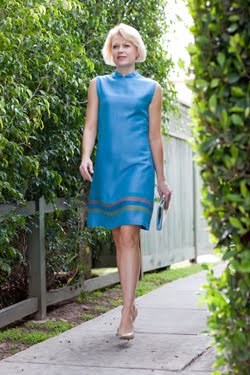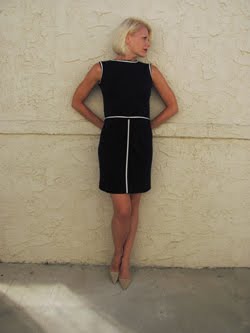One of the themes at this year's TCM Classic Film Festival--Style in the Movies--is Deco Design. Who doesn't love the sophistication of 1920s and 1930s style in film...they are fantasies come to life. I can only imagine the impact on the original Depression-era audiences--tuxedos and silky evening gowns, sparkling jewelry and champagne, and those elegant white sets stealing attention on the big screen. Productions from Our Dancing Daughters (1928) to Dinner at Eight (1933) to Top Hat (1935) all have the qualities of Art Deco. That kind of style still makes an impact today...fashion is currently drawing design inspiration from the era and many looks are on trend in the magazines. Thus, I thought it was the perfect time to focus on the films, fashion, and fantastic architecture of Art Deco style.
Started in 1920s Paris, Art Deco differed strongly from the organic asymmetry of the popular Art Nouveau before it. Linear and symmetical, Deco incorporated chevron patterns and ziggurat shapes--terraced pyramids with each story smaller than the one below it. The popular use of pyramids referenced the excitement over archeology around the world at the time, as travelers unearthed new treasures in Egpyt, Babylon, and Aztec Mexico. And, like many other movements, Art Deco also referenced Greco-Roman classicism. Though the design included this celebration of ancient architecture, Deco was not about the past--it was very much about the present. After all, this was the dawn of the technological era. Oceanliners. Airplanes. Automobiles. Bridges. Skyscrapers. Their images were referenced and incorporated into the art, and then they also all became the art as well. The Empire State Building in New York and the Eastern Columbia Building in Los Angeles (coming soon on GlamAmor) are both magnificent manifestations of Art Deco style.
Art Deco is, at its best, elegant, glamorous, functional, and modern. It's easy to understand why it was so appealing around the world--Deco was both rational and inspirational at the same time. And as technology became more and more a part of people's lives, Deco reacted by loosening its lines and evolving into Streamline Moderne. This incorporated all of the sweeping curves that most people think of with Deco design. In many ways, it can be considered part of the same movement.
There could not be a better way to show both strict Art Deco design and its evolution to Streamline Moderne than Los Angeles City Hall. Built in 1928, its ziggurat shape immediately suggests the symmetry of Deco. Architect John Parkinson, who built many of the best buildings in LA
including Union Station and Bullock's Wilshire, looked to the past for inspiration. City Hall's tower was modeled after the Mausoleum of Mausolus and used concrete made of sand from the 58 California counties and water from its 21 historic missions. Parkinson's Art Deco monument became the tallest base-isolated structure in the world and is for everyone to enjoy--the Grand Room and observation deck atop the 36th floor has spectacular views of all of Los Angeles.
City Hall has made countless appearances in film--both movies and television--and its relationship with Hollywood began right from the start. MGM lent all of its lighting equipment to officials for the opening ceremonies when 250,000 people reportedly attended a parade and celebrated over the three day dedication, including Cecil B. de Mille. I'm sure it looked like one of his epic films. But City Hall is often best known and loved for its prominence in film noir...I most recently featured its Council Chamber here in a scene from Chinatown. So when transitioning from my Month of Film Noir style to one of Art Deco, there is no better place to start than Los Angeles' City Hall.
Welcome to LA.
Construction on City Hall in 1927 (above)
and the dedication ceremony in 1928 lit by MGM
City Hall in 1931 (above)
and today
Entrance to City Hall at 200 Spring Street downtown
Definitely references to Greco-Roman architecture
Courtyard before the main entrance
Blending different references to ancient architecture
while referring to technology in the tile motifs (such as ships and planes)
Entering the building
Exterior and interior views of the elevators--
metals and glass were popular materials of the Art Deco movement
Off at the top where it opens onto the Tom Bradley Room...
the sweeping fluid lines of the marble staircase show the Streamline Moderne of the Art Deco spectrum
The lighting in the building is very Art Deco and Streamline Moderne...
here are two good examples in the Hall of Mayors
Love how I could play with lighting in paintings from the Hall of Mayors
The first thing I see as I climbed the stairs to the Grand Room is the ceiling...
colors that reminded me of ancient art in a room with a scale that's pure Art Deco
In Black and White: 1960s embossed white fit and flare dress, 1960s orange patent leather frame bag,
Nine West black patent leather peeptoe pumps, black and gold bead dangle earrings
The tell-tale tall ceilings of Deco outside on the observation deck
Until 1964, City Hall was the tallest structure in Los Angeles...
today's sleek skyline shows a bit more competition for that title
Birds-eye view of the Bradbury Building, Million Dollar Theater, and Pan American Building (left to right, above)
and Angels Flight
Disney Hall (above)
and the iconic Hollywood sign and Griffith Park Observatory
The Hall of Justice (above)
and Union Station
and Union Station
One moment holding court as Los Angeles Mayor Kimberly Truhler...
before departing for the day
Leaving through a different entrance allows me to see even more building details
and views from the street
"A people cannot have the consciousness of being self-governed
unless they attend themselves to the things over against their own doors."
Sign for the Sister Cities of Los Angeles
and a view of another Art Deco building downtown--The Los Angeles Times
Reflection of City Hall in the beautiful glass-covered building for the Police Department across the street
Saying goodbye to City Hall, but it can always be remembered...
it's been on our police badges since 1940






































































































































5 comments:
I feel like I spent time in LA this morning as I read with eagerness your lovely post on Art Deco buildings! Great kick-off to your new series, Kimberly! And, as always, I'm envious of your blue skies and sunshine...it's 24 degrees here with a foot of snow!
Can't wait for next segment...
Kay
You're too cute for words, dear.
Excellent post; you really captured City Hall as an Art Deco icon. (I would also be pleased to serve in your administration...)
Thanks to you both! It's such a great building in Los Angeles...I'm glad we're able to celebrate it.
And happy to have the first member of my City Council... ;)
Great post! LA City Hall always reminds me of Senate House in London (http://en.wikipedia.org/wiki/Senate_House_%28University_of_London%29).
God, I love Los Angeles...
Post a Comment